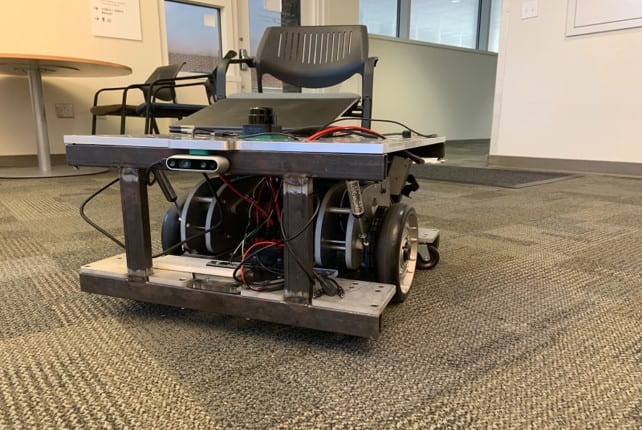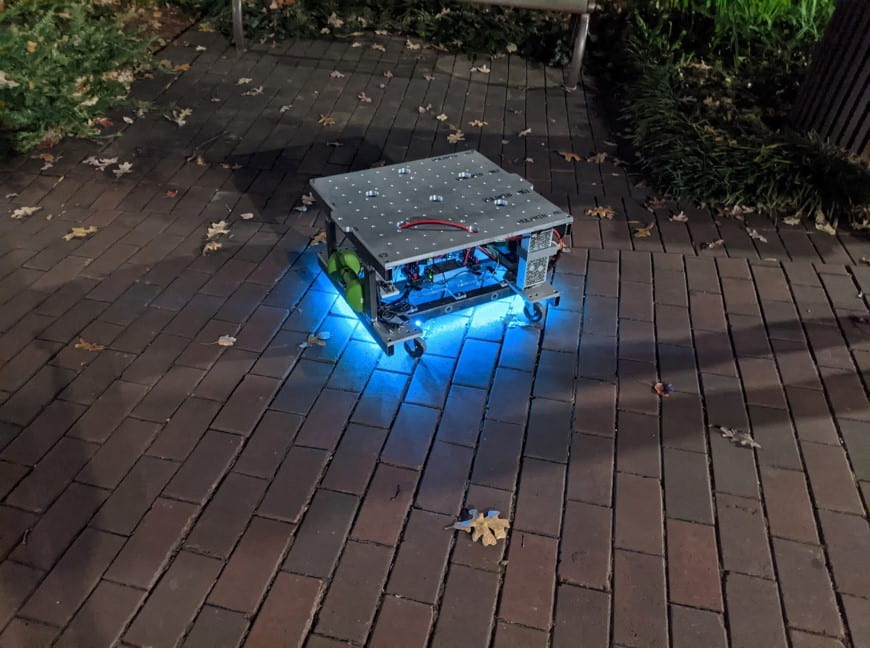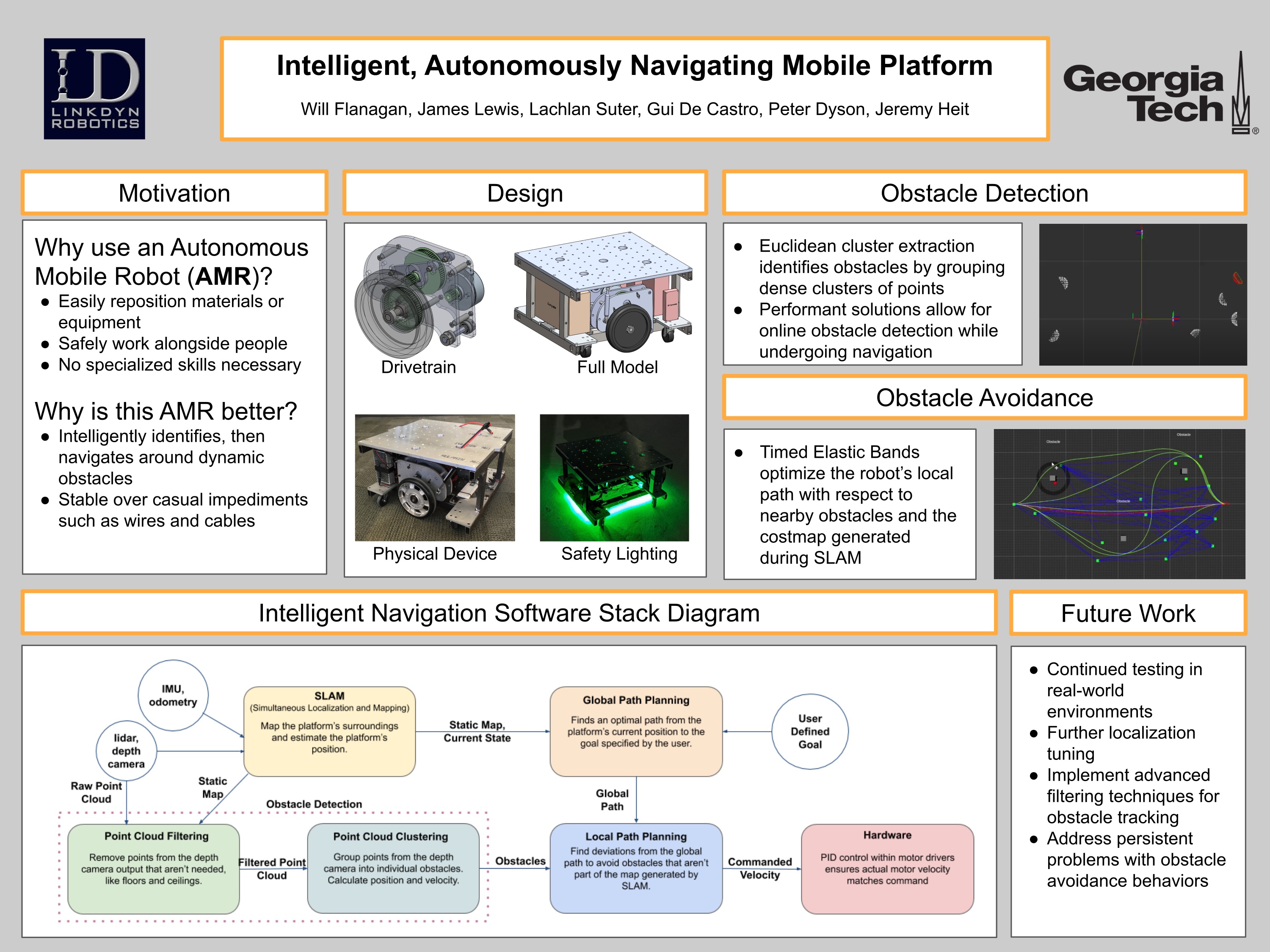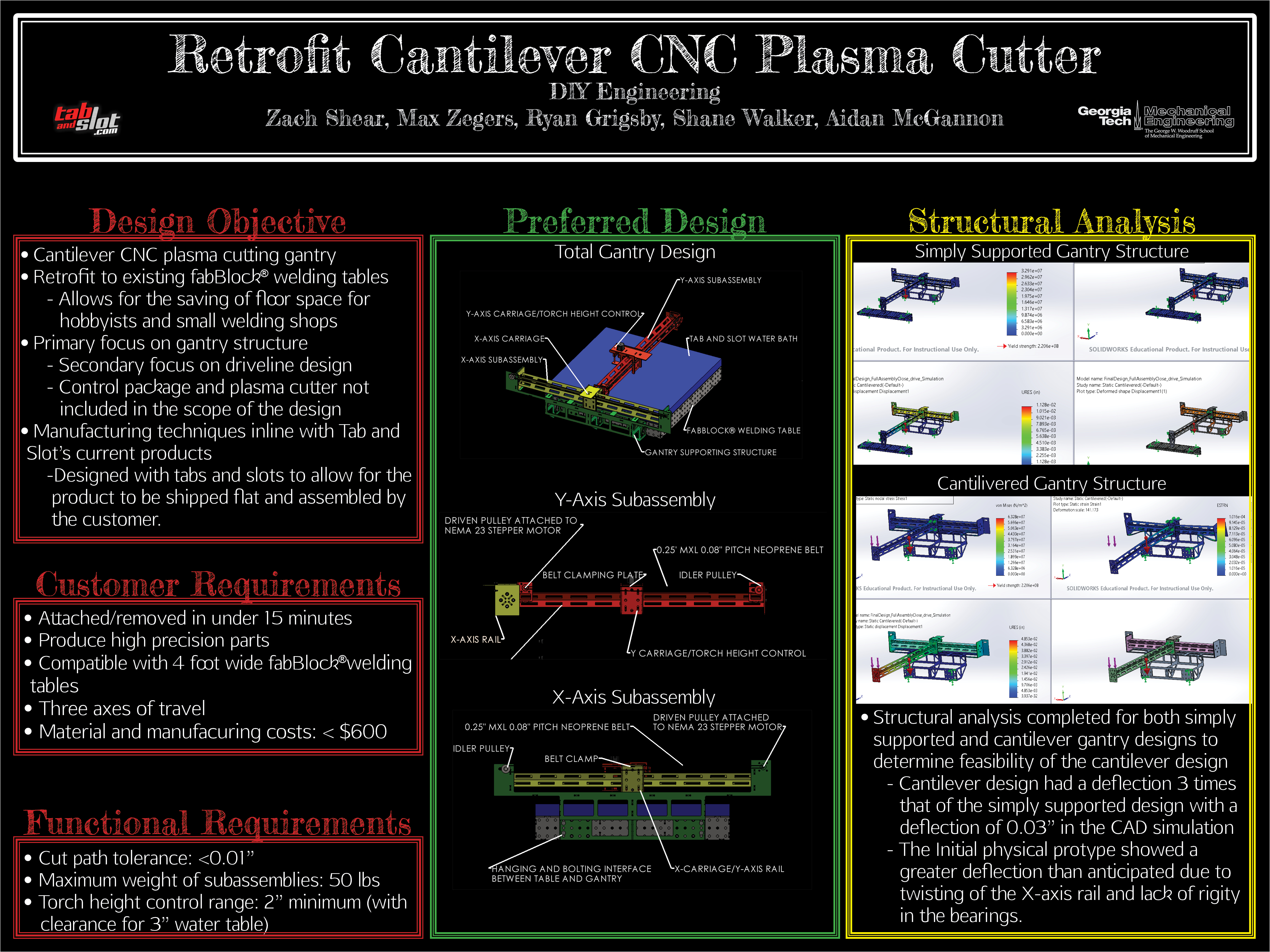











For this Throwback Thursday we interviewed James Lewis, a member of the Helping Hand Team, who supported the creation of the project, “Intelligent Autonomously Navigating Mobile Platform.” With the team’s sponsor, LinkDyn Robotics, they were able to redesign and innovate an older prototype from the company. James was able to present with his group mates, Will Flanagan, Peter Dyson, Lachlan Suter, Jeremy Heit, and Guilherme De Castro, during the Fall 2020 Virtual Expo.
 Platform with drivetrains and sensors removed.
Platform with drivetrains and sensors removed.
 Platform with all sensors and drivetrains attached.
Platform with all sensors and drivetrains attached.
Q: Could you give us a brief description of your project for those who may not know about it?
A: Our project was to redesign and upgrade a prototype mobile platform from our sponsor, LinkDyn Robotics, to improve the device’s manufacturability and obstacle avoidance. These types of robots are often used in warehouse automation for material handling but may also become common within the hospitality industry. Our final product was a 2-foot by 2-foot by 1-foot tall wheeled robot built around a welded steel frame with modular drivetrains. A depth camera and LIDAR sensor were integrated into the design to map the environment and navigate through it. As part of our deliverables, we manufactured our design and wrote the software to demonstrate autonomous navigation in real-world testing.
Q: Where did you first draw inspiration for the idea of the “Intelligent Autonomously Navigating Mobile Platform,” for your Capstone Design Project?
A: LinkDyn Robotics is the maker of a very advanced force-control robotic arm. However, to better serve their customers they needed a way to move their arms around a workspace for tasks like picking and placing inventory on shelves. One of our team members built the first prototype for LinkDyn over the previous summer as an intern, and from this very unpolished design we identified a variety of potential improvements. A lot of inspiration for the design and sensor choice came from looking at existing mobile robots on the market, while the software design was inspired by open-source projects integrated into ROS (Robot Operating System) and research into low-speed autonomous vehicles.
Q: What was the creation process like and how did you and your teammates come together to finish your project?
A: Both the physical and software components of this project were quite demanding, so we split into two subteams to tackle each aspect in parallel. While half the team was working on the mechanical and electrical design, the other half used a simulation environment consisting of ROS and Gazebo to develop and test the autonomous navigation stack. Each member was typically assigned individual tasks and larger group sessions were used whenever an issue posed a persistent problem. In the final weeks before the expo, we met in person to assemble the mobile platform and test.
Q: What were some of the problems that you faced along the way and how did you overcome those obstacles?
A: Since we were working almost entirely remotely, it was difficult to make sure that everybody had access to the same tools and was able to contribute. The mechanical designs were created using Solidworks and synced between members using a shared Google Drive folder. For the software subteam, each member needed access to the ROS+Gazebo simulation environment, but severe compatibility issues arose. To address this issue, we created a docker image with the full set of simulation and development tools we were using.
Q: How did it feel to present your project virtually during this pandemic?
A: Presenting remotely definitely made it harder to connect with the audience and judges. The expo felt less personal and it was much more difficult to fully convey what our project involved. While we put the mobile platform on camera during the presentation to show that we actually manufactured our device, it would’ve been much easier to demonstrate our device in person.
Q: What do you think made your team successful in creating an autonomous mobile platform?
A: Our team spent a lot of time making sure that the transition from simulation to hardware would be smooth. We only had a week or two to test on actual hardware, so any trouble transitioning could have prevented us from successfully demonstrating our work. The Docker environment and Gazebo were crucial for this since it allowed us to run our full stack in simulation in an almost identical manner to the way we ran it on the physical system.
Q: Do you have any advice for future teams?
A: Issue tracking is a great way to formally assign team members tasks, even if those tasks aren’t software related. It also makes it easier for team members to be aware of what others are working on, leading to a more cohesive effort. The importance of communication can also never be understated.



Today, we interviewed Elizabeth Gilbert, a member of the C.I.D. Capstone Expo Team sponsored by Rheem. Their project set out to design a device to heat water without right at the base of a sink without an external source of power. C.I.D. was able to overcome issues as a direct result of the beginning of the pandemic for the Spring 2020 Expo. Today, Elizabeth talks about what she and rest of her group were able to accomplish. Her team included: Casey Brown, Marissa Rubino, Macey Parrott, Evan Ragoowansi, and Mason Hodge.
The C.I.D. Team on a call with blankets and pajamas to showcase what it was really like working on the capstone project for the latter half of the semester.
Q: Could you give us a brief description of your project for those who may not know about it?
A: The project my team worked on for senior design was centered around creating instant hot water for a sink. Our industry partner, Rheem, prompted us to create a ‘black-box’ device that a consumer could, ideally, self-install under their sink to generate instant hot water without an external power input. This project aimed to reduce water waste that comes from running the tap while waiting on the water to warm up.
Q: Where did you first draw inspiration for the idea of your Capstone Design Project?
A: Our team wanted to work on a sponsored project because we felt we could have the most impact that way. We were also primarily focused on thermal systems and agreed that the project with Rheem was both impactful and well within our range of capabilities.
Q: What was the design process like and how did you and your teammates come together to finish the design and research?
A: As funny as it may sound, one of our first inspirations came from a comment one team member made about just putting a hot rock under the sink to warm the water. We were also very fortunate to have two representatives from Rheem come to campus one day and run a guided brainstorming activity with our team, and a lot of ideas came out of that. The design process for our team was fluid, we had good communication between teammates, and with the structure provided by the senior design course, we always knew where we needed to be in the process. Our team had 6 members, so it was easy to divide up into teams of 2 or 3 to split tasks, which is what we did often because it can be difficult to coordinate 6 schedules. We pursued 6 different ideas initially and then cut those down to 3 ideas after feedback from presentations to our faculty advisor and Rheem. Those three ideas were flushed out and eventually narrowed down to one after another round of presentations. Once we did reach a final design idea, we were able to play on team members’ strengths to work towards the completed CAD designs, literature review, and paper.
Q: What were some of the problems that you faced along the way and how did you overcome those obstacles?
A: The largest obstacle that our group faced was the Coronavirus pandemic. Going into spring break, we weren’t sure what to expect, but losing time in the weeks after before school started back and when teachers were trying to restructure class was tough on the group. We rallied along with the rest of the school and found a solution, but it took our project on a very different route. Originally, we had planned to work with Rheem to build the tank that would go under a sink in the final months of the project, but instead, our project became more theoretical with an added a literature review.
Q: What do you think made your project stand out?
A: Our project stood out for its novelty. Even the initial prompt with its lofty goal of no external power input would have been incredible to see come to fruition. The results of the project analyzed the validity of using waste heat recovery across the home to pre-heat the water so it comes out of the faucet at a desired temperature. While innovative, it would be difficult to retrofit such a system in pre-existing homes which is why the project was considered more theoretical in the end. Despite the heavy theory, all the physical exchangers necessary to the project were also designed by the team during this process.
Q: What do you think made your team successful while working with Rheem?
A: Rheem provided us with a lot of helpful feedback and left the door open for a lot of creativity during the whole process. We always had multiple team members that were copied onto email communication with our contact at Rheem to ensure we were timely and efficient at communicating progress, questions, or the need for advice. One of the most helpful things was talking with the plumbers who work for Rheem and getting their experienced feedback as well as that of an R&D team member.
Q: Do you have any advice for future teams?
A: Our advice for future teams is to ensure you build a diverse team with varying strengths. Our group had members with thermal systems experience, manufacturing experience, and CFD experience. This helped us accomplish our tasks much more thoroughly as we could play to our strengths. Another word of advice is that all ideas should be considered. Our group had the policy that no idea is a bad idea, where all members’ ideas were talked through, no matter how far-fetched they sounded at first.
For this Throwback Thursday, we wanted to take a look back at the winning Capstone Design Project from the Fall 2020 Expo made by DIY Engineering. Their project, a Retrofit Cantilever CNC Plasma Cutter, was sponsored by Tab and Slot, which is the company the team drew inspiration from to create their design. Today, we interviewed Zachary Shear, a team member and a 2020 graduate of the Woodruff School of Mechanical Engineering. The rest of the team included Aidan McGannon, Max Zegers, Ryan Grigsby, and Shane Walker.
Q: Could you give us a brief description of your project for those who may not know about it?
A: Our capstone project was to develop a removable CNC plasma cutter attachment for a line of welding tables currently being sold by our industry sponsor Tab and Slot.
Q: Where did you first draw inspiration for the idea of the fabCutter for your Capstone Design Project?
A: We drew inspiration for our design from the existing Tab and Slot line of products. It was important to us that the design was consistent with the other Tab and Slot products and capable of being manufactured in house. These two factors inspired us to use Tab and Slot’s method for creating three dimensional structures out of sheet metal components that are easy to manufacture using their laser cutting capabilities.
Q: What was the design process like and how did you and your teammates come together to finish your project?
A: We utilized an iterative design process to come up with the overall concept for the fabCutter. In the beginning we focused on understanding the existing technology and any constraints we had to work around. Then team members focused on different aspects of the design to ensure that no component was overlooked. In the end, we were very lucky to have access to a shop facility outside of Georgia Tech thanks to Ryan Grigsby. Access to the shop space made it possible for the team to build a prototype and learn things that were missed while virtually developing our product.
Q: What were some of the problems that you faced along the way and how did you overcome those obstacles?
A: The two most difficult problems we faced were the distance from our sponsor and COVID-19 limiting our access to campus resources and our ability to meet with each other in person. Tab and Slot is located in Isanti, MN. All the components they sent us had to be shipped which sometimes resulted in delays that limited the amount of time we had to work. The problem of access to resources was solved by Ryan who was able to secure us access to the shop at his work where we could meet with each other in person.
Q: How did it feel to present your project virtually during this pandemic?
A: Virtually presenting our project had both benefits and drawbacks. The virtual platform allowed us to create a video which streamlined the presentation process. However, when we were speaking or answering questions the virtual platform made it hard to interact with judges and other people watching the presentation. As with everything else during the pandemic, the capstone teams were forced to adapt and develop new skills. Virtually presenting the project was difficult for me, but I’m glad to have had the opportunity to practice that while still in school.
Q: What do you think made your team successful in creating a product that can help small and large metal shops?
A: We focused on making a product that would work for the intended customer. Businesses of that size have a lot of considerations other than equipment capabilities when purchasing a new machine. Our sponsor helped us to understand what the potential customers would be considering so we could take a wholistic approach to designing the fabCutter.
Q: Do you have any advice for future teams?
A: I’d recommend that future capstone teams take the time early in the semester to really understand the scope of their project. Many teams, including ours, were forced to limit the scope of the project toward the end of the semester to have a finished product. If you can start the semester with an achievable project scope you will have significantly more time to spend developing the final project and end up with a better result.


